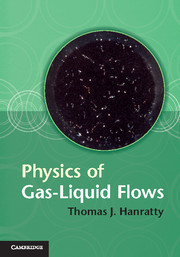3654 results in ebooks in fluid mechanics
1 - Problem solving
-
- Book:
- Problems for Biomedical Fluid Mechanics and Transport Phenomena
- Published online:
- 18 December 2013
- Print publication:
- 09 December 2013, pp 1-15
-
- Chapter
- Export citation
16 - Osmotic pressure
-
- Book:
- Problems for Biomedical Fluid Mechanics and Transport Phenomena
- Published online:
- 18 December 2013
- Print publication:
- 09 December 2013, pp 151-155
-
- Chapter
- Export citation
Appendix B - Transport equations
-
- Book:
- Problems for Biomedical Fluid Mechanics and Transport Phenomena
- Published online:
- 18 December 2013
- Print publication:
- 09 December 2013, pp 158-161
-
- Chapter
- Export citation
9 - Dimensional analysis
-
- Book:
- Problems for Biomedical Fluid Mechanics and Transport Phenomena
- Published online:
- 18 December 2013
- Print publication:
- 09 December 2013, pp 80-86
-
- Chapter
- Export citation
7 - Problems involving surface tension
-
- Book:
- Problems for Biomedical Fluid Mechanics and Transport Phenomena
- Published online:
- 18 December 2013
- Print publication:
- 09 December 2013, pp 70-73
-
- Chapter
- Export citation
4 - Viscous flow
-
- Book:
- Problems for Biomedical Fluid Mechanics and Transport Phenomena
- Published online:
- 18 December 2013
- Print publication:
- 09 December 2013, pp 36-59
-
- Chapter
- Export citation
Appendix C - Charts
-
- Book:
- Problems for Biomedical Fluid Mechanics and Transport Phenomena
- Published online:
- 18 December 2013
- Print publication:
- 09 December 2013, pp 162-168
-
- Chapter
- Export citation
13 - Convection of mass and heat
-
- Book:
- Problems for Biomedical Fluid Mechanics and Transport Phenomena
- Published online:
- 18 December 2013
- Print publication:
- 09 December 2013, pp 119-134
-
- Chapter
- Export citation
10 - Statistical mechanics
-
- Book:
- Problems for Biomedical Fluid Mechanics and Transport Phenomena
- Published online:
- 18 December 2013
- Print publication:
- 09 December 2013, pp 87-89
-
- Chapter
- Export citation
12 - Unsteady diffusion and conduction
-
- Book:
- Problems for Biomedical Fluid Mechanics and Transport Phenomena
- Published online:
- 18 December 2013
- Print publication:
- 09 December 2013, pp 103-118
-
- Chapter
- Export citation
Preface
-
- Book:
- Problems for Biomedical Fluid Mechanics and Transport Phenomena
- Published online:
- 18 December 2013
- Print publication:
- 09 December 2013, pp ix-x
-
- Chapter
- Export citation
Contents
-
- Book:
- Problems for Biomedical Fluid Mechanics and Transport Phenomena
- Published online:
- 18 December 2013
- Print publication:
- 09 December 2013, pp vii-viii
-
- Chapter
- Export citation
References
-
- Book:
- Problems for Biomedical Fluid Mechanics and Transport Phenomena
- Published online:
- 18 December 2013
- Print publication:
- 09 December 2013, pp 169-170
-
- Chapter
- Export citation
6 - Piping systems, frictionfactors, and drag coefficients
-
- Book:
- Problems for Biomedical Fluid Mechanics and Transport Phenomena
- Published online:
- 18 December 2013
- Print publication:
- 09 December 2013, pp 66-69
-
- Chapter
- Export citation
3 - Steady and unsteadyBernoulli equation and momentum conservation
-
- Book:
- Problems for Biomedical Fluid Mechanics and Transport Phenomena
- Published online:
- 18 December 2013
- Print publication:
- 09 December 2013, pp 23-35
-
- Chapter
- Export citation
Permissions
-
- Book:
- Problems for Biomedical Fluid Mechanics and Transport Phenomena
- Published online:
- 18 December 2013
- Print publication:
- 09 December 2013, pp 171-171
-
- Chapter
- Export citation
15 - Mass and heat transfer coefficients
-
- Book:
- Problems for Biomedical Fluid Mechanics and Transport Phenomena
- Published online:
- 18 December 2013
- Print publication:
- 09 December 2013, pp 142-150
-
- Chapter
- Export citation

Physics of Gas-Liquid Flows
-
- Published online:
- 05 November 2013
- Print publication:
- 31 October 2013
5 - Stratified flow
-
- Book:
- Physics of Gas-Liquid Flows
- Published online:
- 05 November 2013
- Print publication:
- 31 October 2013, pp 94-110
-
- Chapter
- Export citation
12 - Horizontal annular flow
-
- Book:
- Physics of Gas-Liquid Flows
- Published online:
- 05 November 2013
- Print publication:
- 31 October 2013, pp 292-330
-
- Chapter
- Export citation
